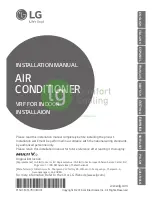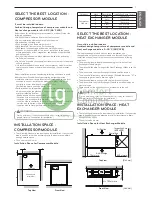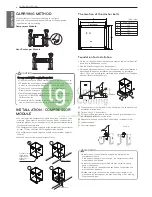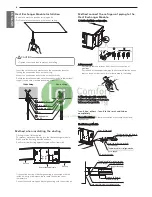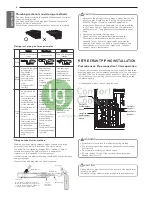
5
ENGLISH
• Do not touch any of the refrigerant piping during
and after operation.
- It can cause a burn or frostbite.
• Do not operate the air conditioner with the panels
or guards removed.
- Rotating, hot, or high-voltage parts can cause
injuries.
• Do not directly turn off the main power switch
after stopping operation.
- Wait at least 5 minutes before turning off the
main power switch. Otherwise it may result in
water leakage or other problems.
• Auto-addressing should be done in condition of
connecting the power of all indoor and outdoour
units. Auto-addressing should also be done in case of
changing the indoor unit PCB.
• Use a firm stool or ladder when cleaning or
maintaining the air conditioner.
- Be careful and avoid personal injury.
• Do not insert hands or other objects through the
air inlet or outlet while the air conditioner is
plugged in.
- There are sharp and moving parts that could
cause personal injury.
• This appliance can be used by children aged from
8 years and above and persons with reduced
physical, sensory or mental capabilities or lack of
experience and knowledge if they have been
given supervision or instruction concerning use of
the appliance in a safe way and understand the
hazards involved. Children shall not play with the
appliance. Cleaning and user maintenance shall
not be made by children without supervision.
TABLE OF CONTENTS
2
TIPS FOR SAVING ENERGY
2
IMPORTANT SAFETY INSTRUCTIONS
6
INSTALLATION PROCESS
6
OUTSIDE UNIT INFORMATION
6
ALTERNATIVE REFRIGERANT R410A
7
SELECT THE BEST LOCATION :
COMPRESSOR MODULE
7
INSTALLATION SPACE : COMPRESSOR
MODULE
7
SELECT THE BEST LOCATION : HEAT
EXCHANGER MODULE
7
INSTALLATION SPACE : HEAT
EXCHANGER MODULE
8
CARRYING METHOD
8
INSTALLATION : COMPRESSOR
MODULE
8
The location of the Anchor bolts
8
Foundation for Installation
9
INSTALLATION : HEAT EXCHANGER
MODULE
10
Heat Exchanger Module Installation
10
Method when insatalling the ducting
10
Method connect the refrigerant piping to the Heat Exchanger Module.
11
Checking the Drainage
11
Indoor Unit Drain Piping
11
Preparation of Piping
12
Plumbing materials and storage methods
12
REFRIGERANT PIPING INSTALLATION
12
Precautions on Pipe connection / Valve operation
13
TO CONNECT THE REFRIGERANT
PIPING TO THE COMPRESSOR MODULE
13
Preparation Work
13
Pipe Drawing Out
14
Refrigerant piping system
14
Selection of Refrigerant Piping
16
Refrigerant charging
16
Distribution Method
17
Branch pipe Fitting
18
Leak Test and Vacuum drying
19
Vacuum Mode
19
Thermal insulation of refrigerant piping
20
ELECTRICAL WIRING
20
Caution
21
Wiring of main power supply and equipment capacity
21
Control box and connecting position of wiring
21
Communication and Power Cables
22
Field Wiring
23
Checking the setting of outside units
23
Automatic Addressing
24
Group Number setting
24
Cool & Heat selector
24
Static pressure compensation mode
25
Night Low Noise Function
25
Setting the ODU address
25
Snow removal & rapid defrost
25
Target pressure adjusting
26
Self-Diagnosis Function
28
CAUTION FOR REFRIGERANT LEAK
28
Introduction
28
Checking procedure of limiting concentration
29
INSTALLATION GUIDE AT THE SEASIDE
29
Model Designation
29
Airborne Noise Emission
www.lgcomfortcooling.co.uk

